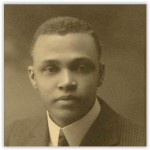(More Information On African Americans)
 Saint Elmo Brady (December 22, 1884 – December 25, 1966) was the first African American to obtain a Ph.D. degree in chemistry in the United States. He received the Ph.D. in chemistry at the University of Illinois in 1916 for work done in Noyes Laboratory.
Saint Elmo Brady (December 22, 1884 – December 25, 1966) was the first African American to obtain a Ph.D. degree in chemistry in the United States. He received the Ph.D. in chemistry at the University of Illinois in 1916 for work done in Noyes Laboratory.
Saint Elmo Brady was born on December 22, 1884 in Louisville, Kentucky. Greatly influenced by Thomas W. Talley, a pioneer in the teaching of science, Brady received his Bachelor’s Degree from Fisk University in 1908 at the age of 24, and immediately began teaching at Tuskegee Institute in Alabama. His magnificent abilities were acknowledged in 1912 when they offered a scholarship to Illinois to engage in graduate studies.
Many years later, he told his students that when he went to graduate school, “they began with 20 whites and one other and ended, in 1916 with six whites and one other.”
During his time at Illinois, Brady became the first African American admitted to Phi Lambda Upsilon, the chemistry honor society (1914) and was one of the first to be inducted into Sigma Xi, the science honorary society (1915). In November 1916, The Crisis — monthly magazine of the NAACP — selected Brady for its biographical sketch as “Man of the Month”. Brady published three scholarly abstracts in Science in 1914-15 on his work with Derick. He also collaborated with Professor George Beal on a paper published in Journal of Industrial and Engineering Chemistry titled, “The Hydrochloride Method for the Determination of Alkaloids.” Professor Brady also authored three monographs on Household Chemistry for Girls.
Brady’s legacy was his establishment of strong undergraduate curricula, graduate programs, and fund raising development for four historically black colleges and universities. In conjunction with faculty from the University of Illinois, he established a summer program in infrared spectroscopy, which was open to faculty from all colleges and universities. He served Tuskegee (1916–1920), Howard University in Washington DC (1920–27), Fisk University (1927–52), and Tougaloo College, following his retirement from Fisk.
Click Here For More Information







